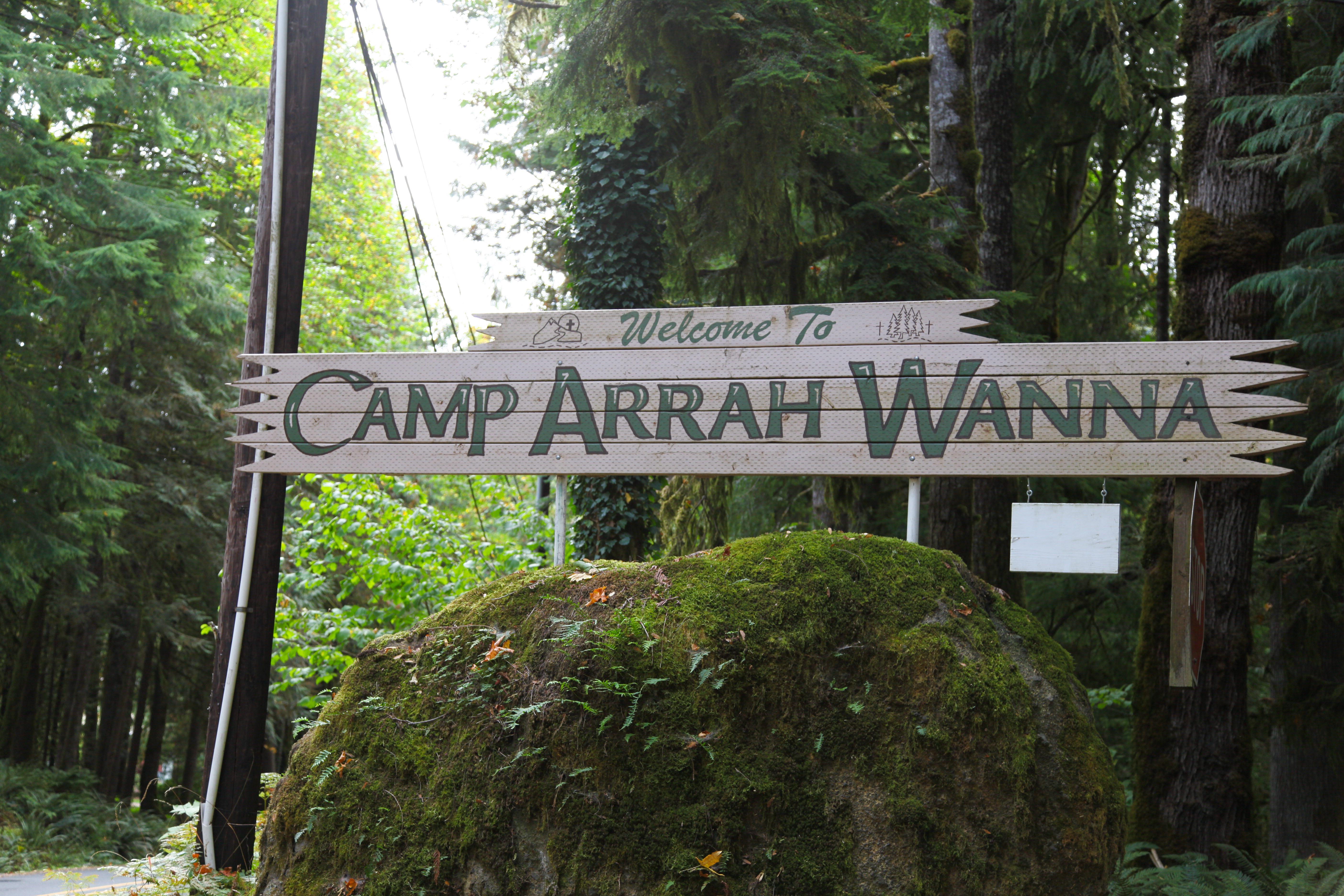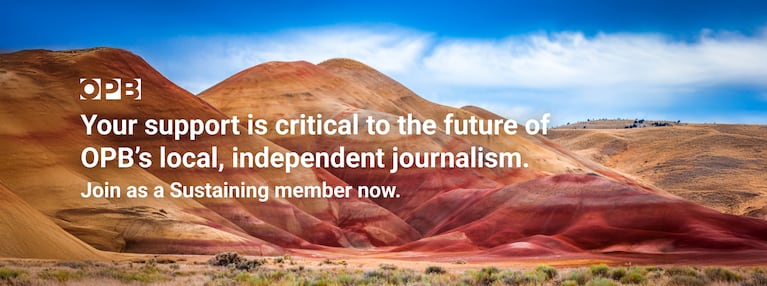A group of Portland sixth graders sits on a shady hillside near Canby. They have hammers in their hands and goggles over their eyes.
They’re saying “physical weathering” to pound a new science term into their heads as they pound rocks. Instructors at Outdoor School go by made-up names. The educator supervising this activity is “Chipmunk,” or “Munk,” for short.

Outdoor School educator “Munk” leads students on a science learning activity at the Canby Grove site near Canby, Ore.
Rob Manning / OPB
“We talked a little this morning about the coloration of rocks, do you know what causes the color of a rock? It’s a word that starts with ‘m’,” asked “Munk,” one of the lead educators at Outdoor School.
“Minerals,” responded a sixth grader named Leyna.
“Yeah, minerals, absolutely,” confirmed Munk.
That lesson led to further discussion of the difference between rocks being smashed to bits as opposed to changing them chemically.
Outdoor School began a big expansion two years ago, promising hands-on science education for thousands more students.
On election night 2016, while the whole country was watching the presidential race, Oregon educators and environmentalists were also quietly tracking Ballot Measure 99. It passed easily, committing the state to spend millions of lottery dollars on Outdoor School and in turn opening the program to more students and allowing more students to attend for the full six days.
The 2016 vote also means less local scrambling to raise money or shift the burden onto public school parents. After its passage, legislators approved $24 million to run the program over its first two school years.
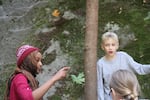
Class Of 2025 students Munira (left, in maroon) and Dude (in gray) take a break from Outdoor School field study at the Arrah Wanna site near Welches, Ore.
Rob Manning / OPB
“When I spoke to some of our families that was their actual concern - they’re like ‘Wow, they’re getting all these things, how much does it cost?'" said Thu Truong, the principal of Ron Russell Middle School in the David Douglas School District in Southeast Portland.
"And I say ‘Nothing! That is the most amazing thing about Oregon Outdoor School.'”
Truong sent students to the longer program for the first time, last month — just in time for the Class Of 2025. OPB has been tracking a group of students in that cohort since they were in first grade, as a way of examining Oregon’s goal that all students achieve a high school credential, starting in 2025.
Like most of the students in OPB’s Class Of 2025, Leyna attends Ron Russell Middle School. She and her classmates bunked in cabins, smashed rocks, hiked through woods, dug in the mud and fondled furry pelts, at several sites across the region.
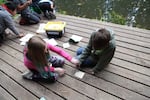
Class Of 2025 students Kaylie (left, in pink sweater) and Jason (right) are testing the acidity of different types of soil at Outdoor School's Kuratli site, near Boring, Ore.
Rob Manning / OPB
Leyna’s site was Canby Grove, south of Portland. Her classmates Kaylie and Jason spent the same week miles east at “Kuratli,” one of the newest Outdoor School sites near Boring. The same day Leyna was pounding rocks with a hammer, Kaylie was checking the acidity of top soil and other materials with one of hundreds of high school volunteers who help run the environmental education programs.
“Can we get other things to test?” Kaylie asked, eyeing a nearby grove of trees.
“Yeah, if you want to grab those tweezers you can grab something else — but not far, like somewhere around here, OK?” said Blue, gesturing to the area close to the pond where the small group of sixth graders was gathered. "Blue" is the high schooler's Outdoor School name.
Going to Outdoor School is full of firsts. For many students, including Leyna and Kaylie, it’s a big deal being away from home for so long.
“The first night, I was really scared because this would’ve been I think the longest I’ve been away from my Mom,” Kaylie said.
“I was just nervous, but then I got to know my cabin-mates and my student-leader, and I don’t want to leave."
Yes, students learn science. But a lot of Outdoor School involves social and emotional growth, by being immersed in an unfamiliar place, surrounded by kids from different schools and backgrounds and learning in a different way. Social-emotional learning is an emerging focus in public education, emphasizing that teachers incorporate students’ emotional well-being into their learning.
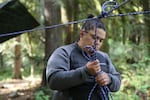
Falco directs the Arrah Wanna Outdoor School program, located in Welches, Ore. He said the full, six-day program now available for students across Oregon is more effective than the three-day program many students had been getting before Measure 99 passed in 2016.
Rob Manning / OPB
Outdoor School is challenging, and it can be especially tough for kids who’ve come from poverty or suffered traumatic childhood experiences. Teachers and leaders such as Ron Russell principal Thu Truong say they make a point of looking out for students who have a harder time adjusting. It can mean giving them a little space, or having an adult spend a little extra time with them.
“It’s definitely a big change, and I think for some of our kids, it’s harder to be gone for this long,” Truong said. “To think about what our kids are coming from, how traumatic this is to be away for six days and five nights, and trying to be thoughtful about it.”
It’s a six-day rollercoaster with a big potential impact. Falco, who directs a site on Mount Hood, said it was tougher to guide students through the emotional transformation, when they were only in the woods for three days and two nights.
Falco said over six days, the program can offer students a chance to re-invent themselves, away from the social circles and cliques their fifth or sixth grade classrooms. In three days, kids may do less reinvention. Falco said a test of the transformation shows up at the end, with a planting ceremony, and going home.
“For the three-day program, we would hope and push and work hard to make sure there were tears on the bus as they left,” Falco said, suggesting the big emotional connection builds naturally in six days.
"I think the difference is that the [six-day] program works itself, whereas we had to make sure that they could feel that impact,” Falco said.
The tougher part of the longer program, Outdoor School leaders say, comes at the front end. Students can feel more intimidated by the length of the time away from home and feel more homesick than they would if they're only facing three days away.
More than 80 percent of students at Ron Russell Middle School are from low-income families, and half come from families in which English isn’t their first language. That includes Class Of 2025 student Leyna, whose parents emigrated from Vietnam.
Truong said it can be hard to explain the importance of the six-day Outdoor School experience to some of her students’ parents.
“If it is a family who is coming from another country, where even the word ‘camping’ is very foreign and has a different kind of connotation, I like to meet with them to be able to explain it,” Truong said.
“They’re like ‘no, we don’t camp,' and I was like ‘OK, we’re not just taking them camping — agreed‚ we’re taking them to school, it’s just over there.'”
Thanks to voter approval of Measure 99, Outdoor School enrollment is projected to rise close to 40 percent over last school year. Oregon State University's extension service, which manages the Outdoor School program statewide, said schools have applied for money to cover more than 42,000 students. That's up from about 30,000 students a year ago.
Considering Oregon has roughly 46,000 sixth graders — and some students will have attended Outdoor School already in fifth grade — the program is nearing its goal of providing Outdoor School to every public school kid, by the end of their sixth-grade year.
The total number of program days is rising even more — by about 45 percent — a reflection of more students attending for six days.
More kids multiplied by more days at the program equals a need for greater capacity. The Multnomah Education Service District, which runs Outdoor School in the greater Portland area, expanded by opening the Boring-area campus where Kaylie and Jason spent their week.
But one of Outdoor School’s biggest benefits has nothing to do with the big numbers or the out-of-the-way locations. Teachers such as Robin Wells at Ron Russell Middle School get to know their students in a very different way.
Related: Outdoor School At Camp Tadmor: Educators, Volunteers And Kids On Why They Keep Coming Back
“I’ve learned about your likes, your dislikes, what makes you upset, what doesn’t make you upset, what do you like to do when you’re at home, what are you missing … why are you up crying?" Wells said outside the dining hall at Canby Grove. “You get to know them like they’re your own child.”
Back at Ron Russell, a week after returning from Outdoor School, students are quick to smile about the experience.
“I didn’t like it, because I loved it,” said Ava, a sixth grader in OPB’s Class Of 2025. "The best parts were making new friends and the food."
A number of Class Of 2025 students said they appreciated the food, meeting people from different schools and being outside, rather than cooped up in a classroom.
“It helped me a lot because I learned stuff on water, plants, soil and animals,” said Josh, another Class Of 2025 student
Josh’s father, Darwin Secrett said he noticed a change in his son after less than a week away. Josh seemed more confident when he stepped off the bus.
Josh’s parents have had their share of difficult conversations with their son’s teachers over the years. As an African-American family, the Secretts want to make sure that Josh is being treated fairly and that his teachers know and support their son.
Darwin Secrett said he appreciated that Josh’s teacher was in the woods, day and night, with his son.
“It was huge in my opinion,” Secrett said. “[Josh] seems more connected with her. And that’s important at this early age. If he has a good relationship with his teachers, it will help him to like school, and then he’ll be more apt, probably to do well in school.”
How kids relate to their teachers and how students deal with tough situations can be big factors in whether students like Josh and Ava, and Leyna and Kaylie will make it to a graduation stage, seven years from now.
“When you spend three days, let alone six days together, you start to really build relationships and trust for that teacher," said principal Truong, reflecting on all her teachers who spend a week at Outdoor School with sixth graders. "You know when you were out here, your Momma and Daddy weren’t here, but your teacher sure was, and she took care of you.”
But after six days and five nights of learning to get along with new people in an unfamiliar place, the Class Of 2025 students might be learning they can take care of themselves a little more, too.
